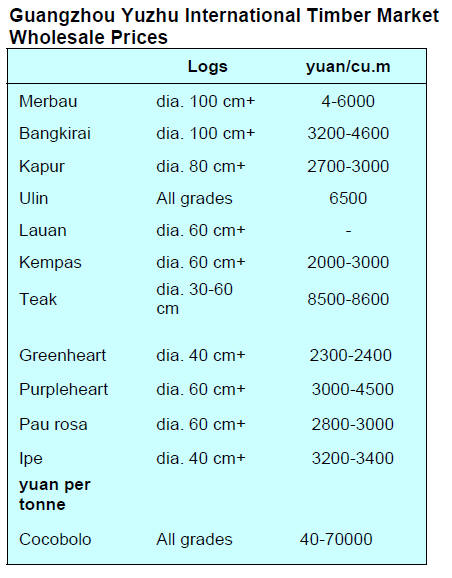US Dollar Exchange Rates of 10th February
2019
China Yuan 6.7722
Report from China
Gloomy Zhangjiagang timber market sales in 2018
The combined effect of strict environmental inspection,
the trade friction between China and the United States and
the volatility of RMB exchange rate coupled with
declining domestic demand is having a big impact on the
level of trade and prices at the Zhangjiagang timber
market. Analysts write that it is the falling domestic
demand that is of most concern to traders.
Zhangjiagang city is the largest distribution centre for
imported timber in China. At present there are 28 timber
markets around the Zhangjiagang Port with an operation
area of more than 1 million square metres and over 2000
timber traders and hundreds of timber processing mills.
About half of these mills have developed in recent years.
Zhangjiagang timber imports account for about 25% of all
timber imports.
The major issue for the industries in the area during 2018
was environmental protection as wood processing plants
become the focus of attention because of their poor
pollution abatement technologies.
Most of the timber enterprises around the Zhangjiagang
Port are family workshops having no effective measures to
deal with pollution. This led to the Zhangjiagang
industries becoming the focus of investigation in 2018.
As many as 60% of wood processing enterprises around
Zhangjiagang Port have been forced to close due to
environment control problems since the beginning of
2018. In addition the domestic economic downturn is
proving fatal for many small enterprises.
The Chinese real estate industry is the mainstay of the
national economy and this suffered a heavy blow in 2018
due to the economic downturn.
Slow business pushes up stocks
Timber stock levels in Zhangjiagang markets remained
high throughout 2018. In November, stocks of okan, a
main species imported, reached almost 60,000 cubic
metres, a volume sufficient to supply downstream
industries for up to six months.
Timber prices at Zhangjiagang markets fell sharply in
2018 due to high stocks and weak demand, it was only
merbau and sapelli for which prices remained more
resilient.
Prices for ebony logs with a diameter of 50-70 cm fell to
RMB2500-2600 per cubic metre in 2018 from RMB4000
per cubic meter in 2017. African rosewood prices dipped
to RMB2300-2500 per cubic metre in 2018 from
RMB3800 per cubic metre in 2017.
Okan was sold at RMB2200-2300 per cubic metre, a year
on year decline of RMB1200-1300 per cubic metre. Ekki
logs with a diameter of 80-100 cm were selling at
RMB2100-2200 per cubic metre, a year on year decline of
around RMB600 per cubic metre.
Dillenia logs with a diameter of 50-70 cm were sold at
RMB2100 per cubic metre, down RMB500 per cubic
metre year on year.
Many timber companies are facing unprecedented
challenges after a good year in 2017. At that time most
businesses had confidence in the2018 market.
Unfortunately, they did not anticipate the sharp downturn
in demand in 2018. All the profits earned in 2017 were
lost in 2018.
Looking ahead, analysts write that traders have concluded
that there is little chance of a turnaround in demand even
after the February Spring Festival.
However, traders see a steady demand for sapelli and
merbau logs as they are very popular species. Sapelli is
very popular for door manufacture and merbau is the first
choice for outdoor furniture and restoration of ancient
buildings.
Depressed redwood sales in Shenzhen city
Located on Longhua district of Shenzhen city in
Guangdong province the Guanlan Redwood Timber
Market is one of the major redwood raw material
distribution centres in the country. This timber market,
which started operations in 1970, has become one of the
largest redwood furniture production bases in China.
As one of the largest redwood raw materials trading bases
in China and because of its efficient distribution network
Guanlan attracted a number of timber markets as well as
major manufacturers. Imported redwood is mainly sold to
mills in Zhongshan, Xinhui, Shanghai, Fujian Xianyou,
Zhejiang Dongyang cities but business is slowing.
But, in the Hongxingshun Second Redwood Market many
plots are empty and there are far fewer buyers compared to
2017. Traders indicate that business is not going well.
Annual shipments of redwood from the Shenzhen Guanlan
New Sunshine Redwood Market fell sharply in 2018
mainly because the number of redwood furniture
companies has shrunk to 1,700 from 3,000 over the past
three years.
 

|